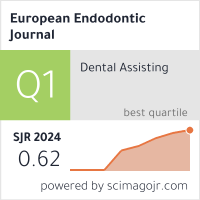Metrics
2024 IMPACT FACTOR
5 year Impact Factor
Eigenfactor Score
2024 CiteScore
Journal Citation Reports
(Clarivate 2025, JIF Rank)
Students Perception of Remote Extended Reality Simulation Systems Using Patient-specific Three-Dimensional-printed Models in Endodontic Education: A Pilot Study
Riyadh Alroomy1, Munirah Almimoni1, Abdulaaly Alotaibi1, Ahad Almutairi1, Ebtesam Alyahya1, Motoharu Unozawa2, Takahito Kakumoto3, Katsushi Okazaki41Department of Restorative and Prosthodontic Dental Sciences, College of Dentistry, Majmaah University, AlMajmaah, Saudi Arabia2Dental Prediction Co., Ltd., Tokyo, Japan
3Kakumoto Dental Clinic, Tochigi, Japan
4Department of Endodontics, New York University, College of Dentistry, DenPre Faculty, New York, USA
Objective: Extended reality (XR) technology using head-mounted devices enables the operator to visu-alise anatomical structures. We aimed to investigate student perceptions regarding applying XR simu-lation for transferring endodontic educational information between a lecturer in Japan and students in Saudi Arabia.
Methods: In this study, the students engaged with an XR simulation system and viewed teeth in virtual reality (VR). Pictures of dental anatomy were shown in the VR space, allowing participants to manipulate them. Then, the participants viewed a patient-specific three-dimensional printed model and three-dimensional root canal access guide in a second VR area. Before the sessions, the students completed a questionnaire on demograph-ic data and information concerning their VR experience. After the sessions, they completed a questionnaire evaluating the XR simulation system. The questionnaire included questions on dental anatomy, root canal access, usability, emotional impression, and data transfer.
Results: Eleven 5th-year dental students, comprising six male and five female students, were enrolled; three of them had previous VR experience, whereas eight did not. The highest levels of satisfaction were noted in the tooth anatomy (4.6±0.4) and emotional impression (4.5±0.5) domains, whereas the lowest level was noted in the data transmission domain (3.5±0.9). Female participants and those without previous VR experience reported higher satisfaction levels across questionnaire domains compared to male participants and those with previous VR experience.
Conclusion: XR can be successfully used in dental education and integrated into online lectures. Restrictions on education caused by health crises can be averted by using XR. Further, fifth-generation networks can offer better data transmission than wireless fidelity.
Keywords: Endodontic education, extended reality, virtual reality, wireless fidelity network
Manuscript Language: English
(437 downloaded)



